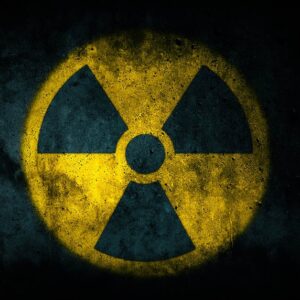
The Chernobyl disaster of 1986 left behind a legacy of devastation, not least of which includes what is now considered the deadliest object on Earth: the Elephant’s Foot.
This ominous mass of radioactive material can kill a person within minutes of exposure, and its eerie presence continues to haunt the abandoned reactor in Pripyat, Ukraine.
The Chernobyl Nuclear Disaster
 Credit: US Department of Energy
Credit: US Department of Energy
On April 26, 1986, reactor 4 at the Chernobyl nuclear power plant exploded during a safety test, leading to the world’s worst nuclear disaster.
The explosion released over 50 tons of radioactive material into the atmosphere, affecting areas as far as France.1
The intense heat caused by the meltdown resulted in the formation of a highly radioactive, lava-like substance that flowed into the basement of the reactor building.
Formation and Composition
 Credit: Wikimedia Commons
Credit: Wikimedia Commons
The Elephant’s Foot was discovered in December 1986, months after the disaster.
It is composed of corium—a mixture of nuclear fuel, molten concrete, and metal, all fused by the intense heat of the reactor meltdown.
This deadly object, which resembles the wrinkled foot of an elephant, is one of the most dangerous radioactive materials known to man.2
The Lethal Effects of the Elephant’s Foot
 Credit: Getty Images
Credit: Getty Images
The radiation levels emitted by the Elephant’s Foot were initially measured at 10,000 roentgens per hour.
To put this in perspective, just 30 seconds of exposure would cause dizziness and fatigue, two minutes would cause severe radiation sickness, and five minutes would result in death within days.
Even years after the disaster, the Elephant’s Foot remained so radioactive that merely being in its presence for a few minutes could be fatal.
Long-Term Hazard
 Credit: MIT Technology Review
Credit: MIT Technology Review
Over time, the radiation levels of the Elephant’s Foot have decreased, but it still poses a significant threat.
The deadly object continues to emit dangerous levels of radiation, and its highly toxic nature means it will remain hazardous for tens of thousands of years.
Researchers and emergency workers who initially documented the mass faced severe health risks, and many developed long-term illnesses from their exposure.
Eerie Visual Evidence
 Credit: Getty Images
Credit: Getty Images
Due to the extreme radiation, it took years before safe photographs of the Elephant’s Foot could be taken.
The first images captured in 1996 show the molten mass in its solidified form, emitting a haunting glow in the dark basement of the reactor.
These photographs are grainy and eerie, a testament to the lethal radiation that even affected the camera film.3
Documenting the Danger
 Credit: Getty Images
Credit: Getty Images
Artur Korneyev, a radiation specialist, is one of the few people documented standing near the Elephant’s Foot.
His photograph, taken a decade after the disaster, shows him in protective gear, highlighting the ongoing risk and the bravery of those who have studied this deadly object.
Korneyev’s exposure led to severe health issues, including cataracts, but he continued his work to understand and mitigate the disaster’s aftermath.
Lessons Learned & Scientific Research
 Credit: Getty Images
Credit: Getty Images
The Elephant’s Foot serves as a grim reminder of the catastrophic potential of nuclear power when safety protocols fail.
Scientists continue to study the mass to understand the long-term effects of nuclear disasters and to develop better methods for handling and containing such materials.4
Recent efforts include replicating the composition of the worlds’ deadliest object in controlled environments to study its properties without the lethal risk.
Ongoing Risks
 Credit: PNNL library
Credit: PNNL library
Despite the construction of a new containment structure over reactor 4, known as the sarcophagus, the area around Chornobyl remains highly radioactive.
The exclusion zone, a 1,000-square-mile area around the plant, is still unsafe for habitation.
Wildlife has returned, but the animals often exhibit mutations and health issues due to the radiation.
Conclusion
 Credit: Wikimedia Commons
Credit: Wikimedia Commons
The Elephant’s Foot is a powerful symbol of the dangers of nuclear energy and the catastrophic consequences of its failure.
It remains one of the deadliest objects on Earth, a chilling reminder of the Chernobyl disaster, and a subject of ongoing scientific study.
The eerie photographs of this radioactive mass serve as a visual testament to the enduring impact of the worst nuclear disaster in history.
News
Breadcrumbing: The Dating Trend That Needs to End
Like most trends, dating trends come and go, which is good news in most cases. For example, being ghosted feels terrible and confusing. Meanwhile, catfishing does both and…
What Does it Symbolize When a Person Who Passed Away Shows up in Your Dream?
There are many theories in relation to whether or not dreams mean anything. Spiritual beings would argue that there’s a lot to learn from a dream. They…
If “this thing” appears on the nail, 3 big problems whether male or female should be careful immediately, check as soon as possible
Suddenly appearing many stripes on the fingernails is also a sign to be careful. Do not ignore it because this can be a sign of illness that…
Astronaut Waves and Flips Camera to Shut Down Flat Earthers Once And For All
Surprisingly, several debates have been proven by science, yet the general public still argues about them. For example, some people believe in science while others believe in…
Scientists Discover a ‘Third State’ of Existence Beyond Life and Death
For centuries, life and death have been considered the ultimate opposites. But now, scientists are discovering a new phenomenon: a “third state” that exists beyond traditional definitions of life and…
The Body Knows When Death is Near, and It Begins in Your Nose
Death is a mysterious and often unsettling subject for many people. Throughout history, humans have tried to understand and anticipate the end of life. Surprisingly, there is some…
End of content
No more pages to load









